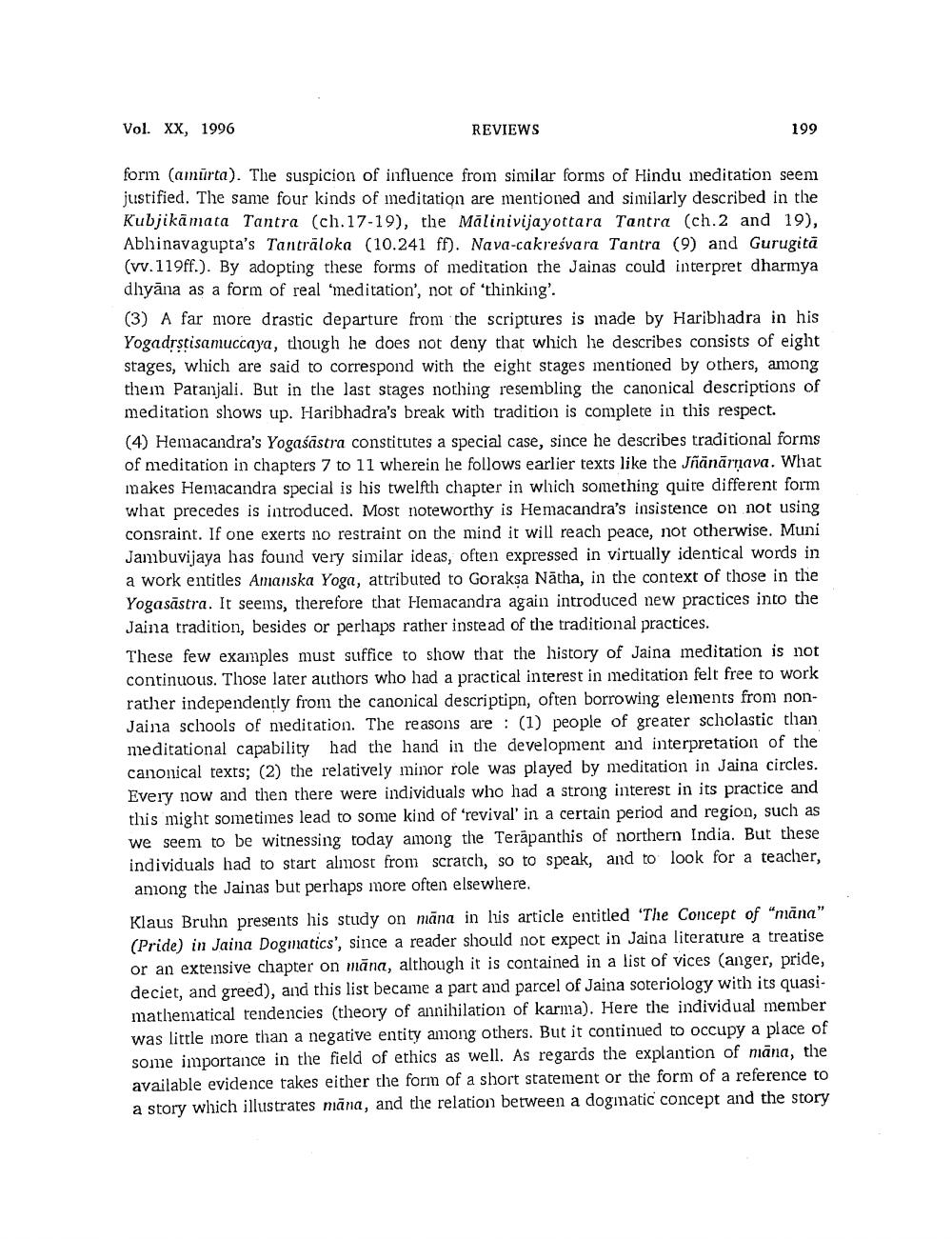________________
Vol. XX, 1996
REVIEWS
199
form (amürta). The suspicion of influence from similar forms of Hindu ineditation seem justified. The same four kinds of meditation are mentioned and similarly described in the Kubjikāmata Tantra (ch.17-19), the Malinivijayottara Tantra (ch.2 and 19), Abhinavagupta's Tantraloka (10.241 ff). Nava-cakreśvara Tantra (9) and Gurugitā (vv. 119ff.). By adopting these forms of meditation the Jainas could interpret dharmya dhyāna as a form of real 'meditation', not of thinking'. (3) A far more drastic departure from the scriptures is made by Haribhadra in his Yogadrstisamuccaya, though he does not deny that which he describes consists of eight stages, which are said to correspond with the eight stages mentioned by others, among them Patanjali. But in the last stages nothing resembling the canonical descriptions of meditation shows up. Haribhadra's break with tradition is complete in this respect. (4) Hemacandra's Yogaśāstra constitutes a special case, since he describes traditional forms of meditation in chapters 7 to 11 wherein he follows earlier texts like the Jñanārnava. What makes Hemacandra special is his twelfth chapter in which something quite different form what precedes is introduced. Most noteworthy is Hemacandra's insistence on not using consraint. If one exerts no restraint on the mind it will reach peace, not otherwise. Muni Jambuvijaya has found very similar ideas, often expressed in virtually identical words in a work entitles Amanska Yoga, attributed to Goraksa Nātha, in the context of those in the Yogasāstra. It seems, therefore that Hemacandra again introduced new practices into the Jaina tradition, besides or perhaps rather instead of the traditional practices. These few examples must suffice to show that the history of Jaina meditation is not continuous. Those later authors who had a practical interest in meditation felt free to work rather independently from the canonical description, often borrowing elements from nonJaina schools of nieditation. The reasons are: (1) people of greater scholastic than meditational capability had the hand in the development and interpretation of the canonical texts; (2) the relatively minor role was played by meditation in Jaina circles. Every now and then there were individuals who had a strong interest in its practice and this might sometimes lead to some kind of 'revival' in a certain period and region, such as we seem to be witnessing today among the Terapanthis of northern India. But these individuals had to start almost from scratch, so to speak, and to look for a teacher, among the Jainas but perhaps more often elsewhere. Klaus Bruhn presents his study on māna in his article entitled 'The Concept of "mana" (Pride) in Jaina Dogmatics', since a reader should not expect in Jaina literature a treatise or an extensive chapter on māna, although it is contained in a list of vices (anger, pride, deciet, and greed), and this list became a part and parcel of Jaina soteriology with its quasimathematical tendencies (theory of annihilation of karma). Here the individual member was little more than a negative entity among others. But it continued to occupy a place of some importance in the field of ethics as well. As regards the explantion of niāna, the available evidence takes either the form of a short statement or the form of a reference to a story which illustrates māna, and the relation between a dogmatic concept and the story




